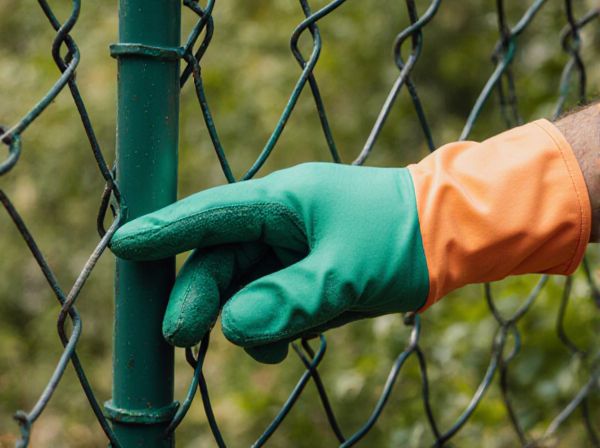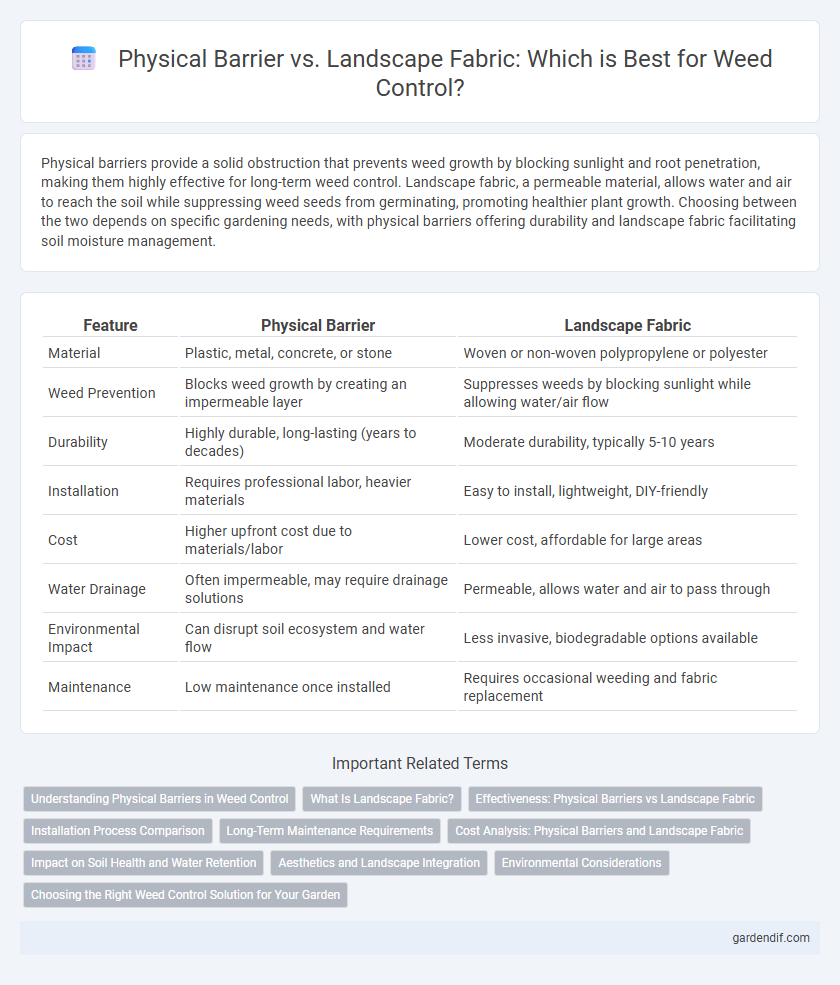
Physical Barrier vs Landscape Fabric Illustration
Physical barriers provide a solid obstruction that prevents weed growth by blocking sunlight and root penetration, making them highly effective for long-term weed control. Landscape fabric, a permeable material, allows water and air to reach the soil while suppressing weed seeds from germinating, promoting healthier plant growth. Choosing between the two depends on specific gardening needs, with physical barriers offering durability and landscape fabric facilitating soil moisture management.
Table of Comparison
| Feature | Physical Barrier | Landscape Fabric |
|---|---|---|
| Material | Plastic, metal, concrete, or stone | Woven or non-woven polypropylene or polyester |
| Weed Prevention | Blocks weed growth by creating an impermeable layer | Suppresses weeds by blocking sunlight while allowing water/air flow |
| Durability | Highly durable, long-lasting (years to decades) | Moderate durability, typically 5-10 years |
| Installation | Requires professional labor, heavier materials | Easy to install, lightweight, DIY-friendly |
| Cost | Higher upfront cost due to materials/labor | Lower cost, affordable for large areas |
| Water Drainage | Often impermeable, may require drainage solutions | Permeable, allows water and air to pass through |
| Environmental Impact | Can disrupt soil ecosystem and water flow | Less invasive, biodegradable options available |
| Maintenance | Low maintenance once installed | Requires occasional weeding and fabric replacement |
Understanding Physical Barriers in Weed Control
Physical barriers in weed control, such as concrete or metal edging, effectively prevent weed roots from spreading by creating an impenetrable boundary. Unlike landscape fabric, these barriers do not degrade over time, ensuring long-term protection against invasive weeds. Investing in durable physical barriers reduces maintenance efforts and supports sustainable weed management in gardens and landscapes.
What Is Landscape Fabric?
Landscape fabric is a geotextile material designed to suppress weed growth by blocking sunlight while allowing water and air to penetrate the soil. Unlike physical barriers such as plastic sheeting, landscape fabric is porous, promoting healthier plant roots and soil structure. It is commonly used in gardens and landscaping projects to reduce weed maintenance and improve plant growth conditions.
Effectiveness: Physical Barriers vs Landscape Fabric
Physical barriers, such as metal or plastic edging, effectively block weed intrusion by creating a solid, impenetrable boundary that prevents root and rhizome expansion. Landscape fabric allows water and air to penetrate while suppressing weed growth, but its effectiveness diminishes over time as UV exposure breaks down the material and weeds can grow through holes or decomposed areas. Choosing between physical barriers and landscape fabric depends on long-term durability requirements and the specific weed species targeted in garden management.
Installation Process Comparison
Physical barriers require precise trenching to ensure edges are securely buried, preventing weed intrusion, while landscape fabric installation involves laying the material flat over prepared soil and securing it with staples or pins. The installation of physical barriers often demands more labor and equipment to achieve a durable, long-lasting solution, whereas landscape fabric provides a quicker, more adaptable method ideal for various garden shapes. Both methods must be meticulously sealed at seams and edges to maintain effective weed control and soil health.
Long-Term Maintenance Requirements
Physical barriers made from rigid materials like metal or concrete provide robust, long-lasting weed control with minimal maintenance but require professional installation and higher upfront costs. Landscape fabric offers effective short- to medium-term weed suppression, needing regular inspection and occasional replacement due to fabric degradation and weed breakthrough. For long-term maintenance, physical barriers significantly reduce labor and material inputs, while landscape fabric demands ongoing upkeep to sustain weed prevention.
Cost Analysis: Physical Barriers and Landscape Fabric
Physical barriers typically involve the use of concrete, metal, or plastic edging, costing between $2 to $10 per linear foot, which can result in a higher initial investment but offers long-term durability. Landscape fabric prices range from $0.15 to $0.75 per square foot, providing a more cost-effective option for large areas but may require replacement every few years due to degradation. When comparing cost efficiency, physical barriers offer a one-time expense with minimal maintenance, whereas landscape fabric demands periodic replacement and weed control supplements.
Impact on Soil Health and Water Retention
Physical barriers such as plastic sheets effectively suppress weeds but often hinder soil aeration and water infiltration, negatively impacting soil health and moisture retention. Landscape fabric allows water and air to penetrate, promoting beneficial microbial activity and maintaining soil structure, which enhances long-term water retention. Choosing breathable landscape fabric supports healthier soil ecosystems while still providing effective weed control.
Aesthetics and Landscape Integration
Physical barriers provide a clean and durable solution for weed control while maintaining a visually appealing landscape by using materials like metal or plastic edging that blend seamlessly with garden design. Landscape fabric offers a more subtle integration by being buried under mulch or soil, which helps preserve natural aesthetics and supports healthy plant growth without disrupting the overall appearance. Both methods enhance landscape aesthetics by minimizing weed growth and protecting soil structure, with landscape fabric offering a softer, more natural look compared to the structured appearance of physical barriers.
Environmental Considerations
Physical barriers such as concrete or plastic sheets provide an impermeable layer that prevents weed growth but can disrupt soil aeration and water infiltration, negatively impacting local ecosystems. Landscape fabric allows for water and air exchange, promoting healthier soil biology while suppressing weeds, though it may degrade over time and require replacement. Choosing between these options involves weighing the long-term environmental impact on soil health and biodiversity against the effectiveness of weed control.
Choosing the Right Weed Control Solution for Your Garden
Physical barriers such as plastic sheets or cardboard provide effective blocking of weed growth by preventing sunlight penetration, making them ideal for long-term weed control in garden beds. Landscape fabric, made from woven or non-woven materials, allows water and air to pass through while suppressing weeds, offering a balance between soil health and weed prevention. Selecting the right solution depends on garden type, desired soil aeration, and maintenance level, with physical barriers suited for more permanent beds and landscape fabric preferred for vegetable gardens or areas requiring more drainage.
Physical Barrier vs Landscape Fabric Infographic

 gardendif.com
gardendif.com